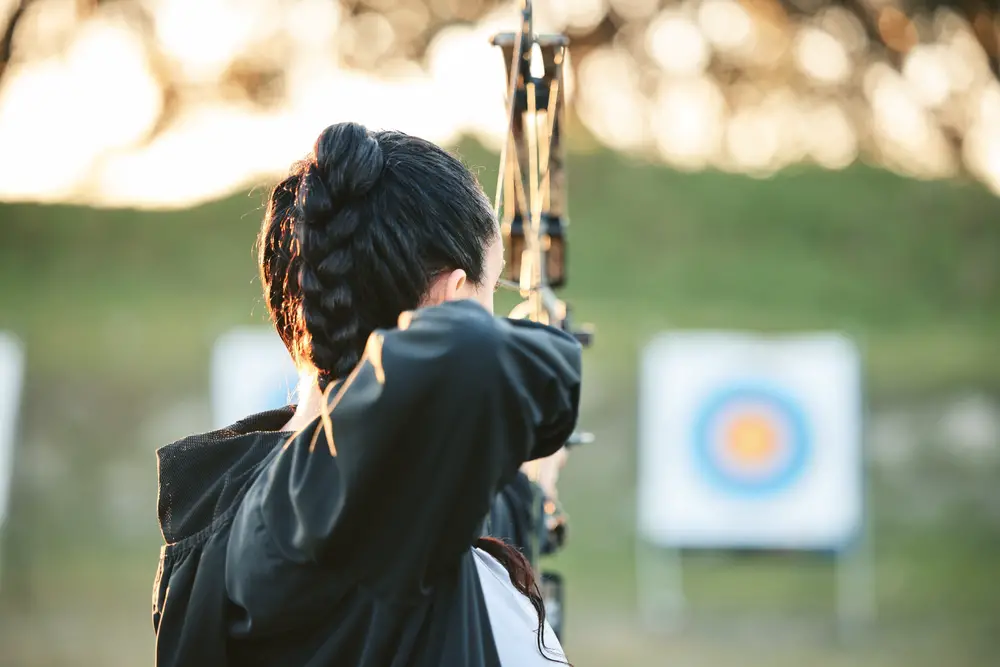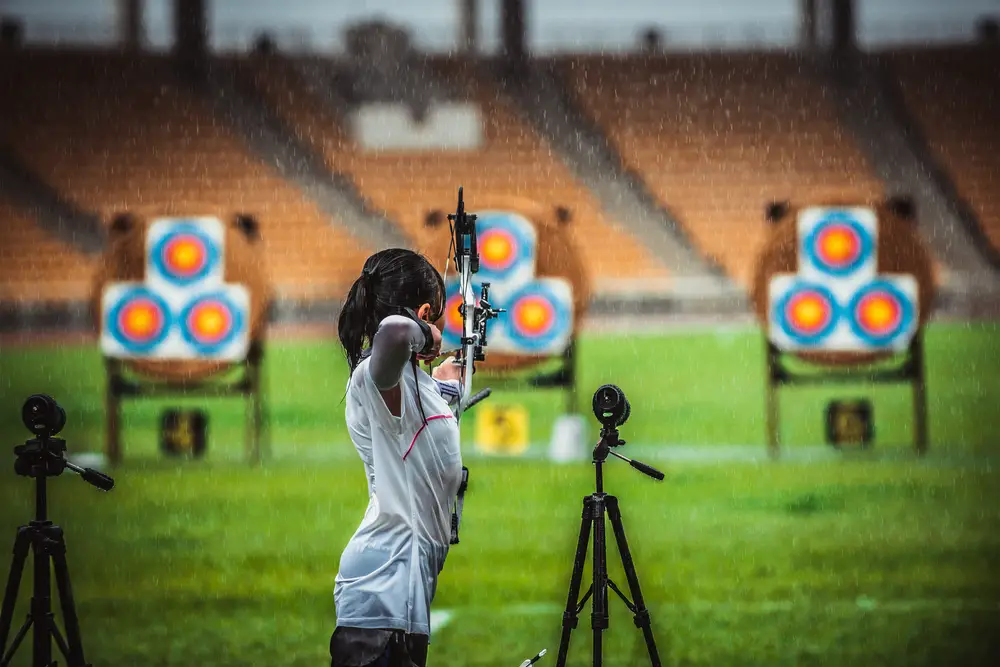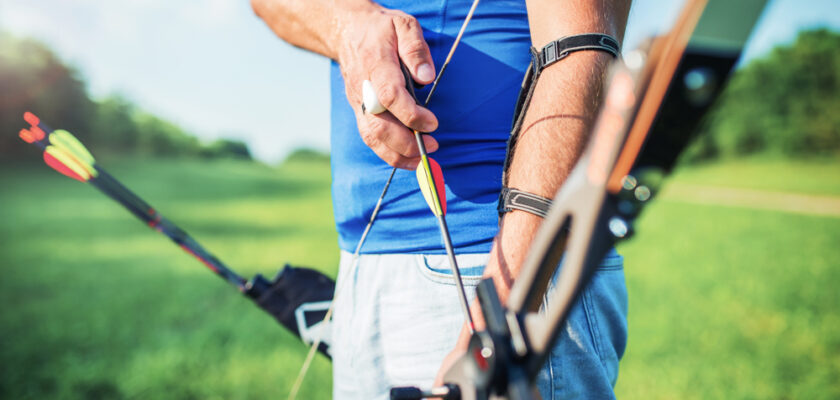Archery is a sport that emerged in the earliest human civilizations, as it was used for both hunting and war.
Over the centuries, the activity has evolved into a sport of precision, technique and concentration. Today, it is practiced in competitions around the world and has been an Olympic sport since 1900.
The practice of bow shooting requires a lot of physical skill on the part of the athletes, as well as a great deal of knowledge of the equipment used and the techniques involved in the activity as a whole.
Therefore, understanding the sport’s specific terms is crucial for anyone who wants to delve deeper into archery, or just admire the sport.

With this in mind, we’ve created a list of the glossary of archery. In it, you’ll see the most commonly used terms in the sport and what they mean. By knowing these words, you’ll learn much more about the sport!
So check out the glossary of archery!
Open your Betano account and get up to 1,000 reais in bonuses.
Payments via PIX, live games and super odds!
Click here to open your account!
Archery glossary: complete list
- Quiver
- Finger Ring
- Compound Bow
- Long Bow
- Recurve Bow
- Bracelet
- Nocking pin
- Rope
- Trigger
- Handle
- Stabilizer
- Arrow
- Nock
- Feathers
- Quiver
- Recurve
- Release
- Spine
- Tab
- Anchoring Technique
- Release Technique
- Instinctive Shooting
- Olympic Shooting
- Vanes
- Display
- Traction weight
Glossário do tiro com arco: saiba mais sobre os termos
Quiver
A quiver is a container used to carry arrows. It can be made of different materials, such as leather, fabric or plastic, and can be worn around the waist, on the back or even attached to the bow. The choice of quiver depends on the archer’s preferences and the type of shooting they do.
Finger ring
In archery, the finger ring is an accessory worn by athletes, especially in traditional styles such as the Asian recurve bow. It is placed on the thumb or other fingers to protect the skin from constant friction with the bowstring when releasing the arrow.
Compound bow
The compound bow is a modern type of bow that uses a pulley system to increase the power and efficiency of the shot. This system allows the archer to keep the string taut with less effort, providing greater precision and power.
Longbow
The longbow is a type of traditional bow known for its long, simple shape. It is usually made of wood and does not have curved ends, which distinguishes it from the recurve bow.
Recurve bow
A recurve bow is a type of bow in which the ends curve away from the archer when the bow is unstrung. This helps it store more energy and provides a more powerful shot. This is the type of bow used in Olympic competitions.
Bracelet
The bracelet, or arm protector, is worn on the archer’s forearm to protect him from the impact of the bowstring when it is released. This accessory is essential for preventing injuries and improving accuracy by preventing the string from hitting the arm and deflecting the arrow.
Nocking pin
The nocking pin in archery is a small ring or mark on the bowstring where the arrow is placed before shooting. This mark helps to ensure that the arrow is always in the correct position, contributing to the consistency of the shots.
String
The string is the part of the bow pulled to launch the arrow. It is made of resistant materials and is designed to withstand the strain and wear of continuous use.
Trigger
The trigger, or release, is a device used by compound archers to release the bowstring. It is held by the hand and activated by a trigger, providing a smoother and more accurate shot.
Grip
The grip is the part of the bow that the archer holds with the non-dominant hand. A comfortable, well-designed grip is essential for maintaining stability and accuracy when shooting.
Stabilizer
In archery, the stabilizer is an accessory that attaches to the bow to reduce vibrations and improve balance during the shot. It helps keep the bow stable and improve accuracy, especially for long-distance shots.
Arrow
The arrow is the projectile fired by the bow. It is made up of a shaft, a tip, feathers (or vanes) and a nock. Arrows can be made from different materials such as wood, aluminum, fiberglass or carbon.
Nock
The nock is the name given to the rear end of the arrow that fits onto the bowstring. It is designed to ensure that the arrow is well positioned and ready to fire.
Feathers
Feathers, or vanes, are the fins on the back of the arrow that help stabilize it during flight. They can be made of natural feathers or synthetic materials and are essential for better shooting accuracy.
Quiver
A quiver is an alternative term for a quiver, used mainly in international competitions and contexts. It is used to store and transport arrows in a safe and practical way.
Recurve
Recurve is a characteristic of certain bows in which the ends curve outwards, providing greater shooting efficiency. It is the type of bow used in the Olympics and in many archery competitions.
Release
Releasing is the act of releasing the bowstring in order to shoot the arrow. The technique of releasing the string in a smooth and controlled manner is crucial to archery accuracy.
Spine
Spine refers to the stiffness or flexibility of the arrow shaft. It is an important characteristic that affects the arrow’s accuracy and performance in flight.
Tab
The tab is the name given to a small piece of leather or other material used to protect the archer’s fingers when pulling the bowstring. It is mainly used by recurve archers.
Anchoring technique
The anchoring technique is the position in which the hand pulling the string fixes itself on the archer’s face or chin before releasing the arrow. Consistent anchoring is essential for accuracy.
Release technique
The release technique refers to the method used by the archer to release the bowstring. A smooth, controlled release is fundamental to shooting accuracy.
Instinctive shooting
Instinctive shooting is an archery technique in which the archer does not use a scope. They rely on their intuition and practice to hit the target, and it is a common technique in traditional styles.
Olympic Shooting
Olympic shooting refers to the style of archery used in Olympic competitions, which uses recurve bows and follows specific rules established by the International Olympic Committee.
Vanes
Vanes are the fins at the back of the arrow, also called feathers. They help stabilize the arrow during flight and can be made of natural or synthetic materials.
Sight
The sight is a sighting device attached to the bow, used to help the archer align the shot. It can be adjusted for different distances and is essential for more accurate shooting.
Anchoring technique
The anchoring technique is the practice of consistently placing the hand that pulls the string on a fixed point on the archer’s face, ensuring more accurate and consistent shots.
Release technique
The bowstring release technique is crucial for good accuracy. A smooth, controlled release prevents drift and improves shooting accuracy.
Draw weight
The draw weight in archery is the amount of force needed to pull the bowstring to the anchor position. It is measured in pounds (lbs) and varies according to the type of bow and the strength of the archer.

Archery glossary: complete list
- Quiver
- Finger Ring
- Compound Bow
- Long Bow
- Recurve Bow
- Bracelet
- Nocking pin
- Rope
- Trigger
- Handle
- Stabilizer
- Arrow
- Nock
- Feathers
- Quiver
- Recurve
- Release
- Spine
- Tab
- Anchoring Technique
- Release Technique
- Instinctive Shooting
- Olympic Shooting
- Vanes
- Display
- Traction weight
Archery glossary
Did you enjoy getting to know the glossary of archery? Now that you know more about this sport, which is also widely practiced at the Olympics, you can explore our other articles on the subject.
Also, if you’ve made it this far, leave a comment telling us what you thought of the content and what other types of articles you’d like to see here!



